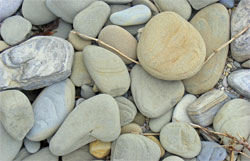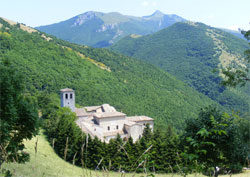
CdP
11 July 2013
Finally, a grey day, threatening rain right from the start. Maybe I’ll get some work done and not be lured out by the magic of blue skies. Then again, in this strange, almost tropical season, that temptation is often truncated round about 4.30pm when things go cloudy, loud rumbling begins and – now and then – huge raindrops thump down.
So far we have escaped hail, thankfully. But nothing that happens now, meteorologically speaking, surprises us, and as I pay my regular visits to my little tomato plants,to tie them to their poles and pinch out their axillary shoots, I wonder whetherperhaps I shouldn’t be throwing some kind of protection over them, justin case. Driving to Arezzo last weekend, we passed hectares and hectares of somethingleafy swathed like a Christo installation in thin white horticultural fleece:it was grapes, we realised, and a wine producer determined not to suffer thefate of many around here this summer who have seen their year’s crop puncturedand battered to the ground.
Arezzo was lovely, but worrying. I love the way the central piazza has no Benetton,or Zara, or anything in fact except discreet antique shops and other tiny frontageswith nothing in the way of garish signs or modern excrescences. We went for theantiques fair, which happenseach first weekend of the month. In past years, it has been a heaving mass ofhumanity among the stalls whichoccupy the whole centro storico. When we arrived last Saturday, around lunchtime, it was very quiet. Our hearts sank: the restaurants would be packed. Butno, they were rattling too. Talking to a stall-holder, she told me it had beenthe most disastrous year. It rained just about every weekend through the winter.Now that summer has come, people are either out of the habit or just too poor.She reckons that from 1000 stalls, there are now only about 250 on most weekends.We bought two 1950s armchairs from her to brighten up her day. The only goodthing (from our point of view) is that prices have gone way down. I hope we weren’ther only customers.
We also discovered the truly wonderful Ditta Grilli (corso Italia 84), whichhas just about everything you didn’t know you needed for your home. Webought a boot jack with stiff bristly brushes on either side – one horizontaland one vertical – for mud removal. Now it squats by the wellies in thechicken house looking like some strange animal waiting to pounce and scares mewitless every time I go in there. And I bought metres and metres of lovely roughhessian to make the awning for the pergola in the orchard. If I ever get aroundto it.
While C was over for some respite from MA-dissertation-writing, we took fourdays to explore a bit of Le Marche. L was working of course: we were fairly focussedon stylish hideaways and fine food. Urbino is spectacular, but then we knew that.I had forgotten quite how intricate the marquetry was in the library of the ducalpalace. Urbino is good because it’s lived in – a real universitytown rather than a cutesy tourist attraction.
Unlike the nightmarish Gradara.It was in thecastle here – according to a legend neatly cooked up in very recent timesto bring tourists piling in by the grockly coach load – that Dante’sPaolo and Francesca fell tragically in love. In fact, it’s rather a magnificentmedieval pile and if you happen to enjoy pastiche – which I do – theimprobable faux-med makeover given to the place by an owner with more money thansense or taste in the 1920s is rather amusing. But the village around the castle!I have seen nothing quite like it since I went to San Marino many years ago.It’s a pretty hamlet transformed into a lowest-common-denominator shoppingmall for undiscerning visitors… the kind who spend more time browsing theunspeakable offerings on its souvenir stalls (a black truncheon with ‘MussoliniDux’ stamped on it anyone?) than appreciating the place they’re in.Truly a circle of Dantean hell.
On the plain below the village, there’s another site, of immeasurable pathosand tear-jerking loveliness. There are almost 2000 Commonwealthsoldiers buriedalong terraces beneath olive trees.I suppose we somehow convince outselves that in times of mass killing, peoplebecame resigned or numbed to losing loved ones. But on each of the whitegravestones, down the bottom, there was a space for family to dedicate a fewwords. The thought of the uncomplicated wrenching heart-ache of these makes mewant tocry all over again. There was hardly anyone buried there over 40. Most, though,were under 25. There should be a rule, I think, sanctioned by every nation onearth, that only people aged 40 and over can fight in wars. Those men in, andbarely out of, their teens didn’t create that conflict. They had nothinginvested anywhere to kill others and be killed themselves for. Let the peopleresponsible for picking the fight in the first place, and people with more materialthings to lose (as opposed to those with their whole, barely begun lives to sacrifice)do the fighting. We might find a whole lot more people objecting.
That area between Urbino and Pesaro/Fano is (like much of rural Marche) an areaout of time. It’s busily agricultural but wild and unspoiled as well. Yousee lines of scarved and hatted contadini hoeing between long, long rows of onionsor potatoes, looking much as they would have looked in the 16th or 17th or whatevercentury you choose; and vegetable gardens are ringed by vines growing from treeto tree – viti maritate, or married vines – a technique that datesback at least as far as the Etruscans. Crushing poverty lasting until fairlyrecently is probably responsible for the (relative) lack of ghastly jerry-builtconstructions blighting the landscape. So many of the villages are just tinycircles of ageless organic-looking pale stone – no concrete round the edges.
Over towards the sea – and much of the coast here is sheer: there are longstretches of tiny coves hollowed out of cliff, rather than interminable beachumbrellas – the SanBartolo nature reserve has preserved the character and flora of that stunningstretch. Pomegranates grow in profusion, everywhere. There are great toweringhedges of them.
I thought of this when talking to my friend S, whom I’m helping with hersoon-to-be garden. She was seeking a plant for the hedge around her carport,to make sure no cars can be seen from the house. I suggested pomegranate. “Ugh,orange!” she said. “Worse than yellow!” That’s fine – everyoneis entitled to their own colour scheme (within reason…) and if her gardenbecomes a cool space of whites and silver-greys and pinks and dark purple (Ihave given her dozens of the rhyzomes from the irises I am currently busy divising)it will be truly lovely. I was thinking about this, and wondering whether myattempts to embrace all colours (evenyellow!)were too generous. But in the end I decided I just love plants – all kindsof plants – too much to banish huge numbers of them by sticking to a narrowpalette. The more pomegranates, with their vibrant green foliage and joyous flowers,the better.




